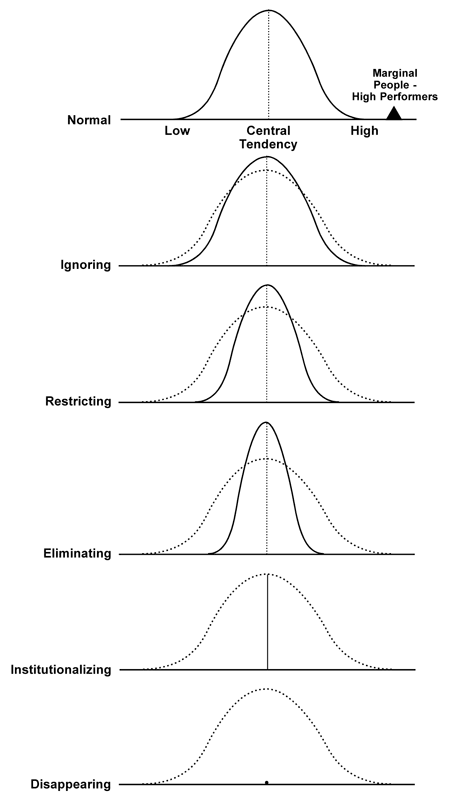Freedom and Generativity:
1. Totalitarianism and Variability
The differences between Freedom and Totalitarianism may be heard in the tale of the peasant who, upon his way to work, discovers a genie in a bottle. Having escaped the bottle, the genie inquires as to the peasant’s “one wish.” The peasant replies:
“I have eight cows and my neighbor has 16. I’d like you to kill eight of his.”
Historically, culture has been viewed as groupings of people by racial, ethnic and national characteristics. Assumedly, without an understanding of cultural heritage, the economic and social endeavors of these people might not be understood. In this context, then, culture extends to give meaning to the economic, social, and political as well as the esthetic and intellectual character of peoples.
Inherent in the assumptions of culture is the principle that culture is defined by past traditions. In point of fact, no matter how beautiful the music, art and literature, culture is defined by conditioned responding systems appropriate to the requirements of the conditions under the Totalitarian Systems of their times.
Somewhere at the end of the 20th century, a new definition of culture evolved. In this definition, culture is defined futuristically by the evolving requirements of The Global Village and Its Marketplace. This is the Generative Definition of Culture. This definition does not exclude traditional values. Rather, like the enlightened individual making a critical decision, the person employs The Freedom Matrix to relate values to requirements in an attempt to maximize both.
The Freedom Wars began with the emergence of America and its evolving Freedom Systems:
- States that related collaboratively and peacefully,
- States that generated extraordinary wealth,
- States that were governed by their policy-making citizens.
Together, these states converged to generate the most free and collaboratively relating, enterprising and governing system in the history of humankind, the U.S.A. In so doing, the U.S. defined The Freedom Systems in the futuristic terms of Cultural Relating, Free Enterprise and Participative Governance.
Simultaneously, the Totalitarian Cultures of the world have risen up to attack and, now, terrorize the Freedom Systems. Having flunked The 20th Century Tests of Totalitarianism, leaving 150 million dead behind their empty promises and deathly weaponry, these Totalitarian Cultures now seek to slow-down, weigh-down, batter-down the Freedom System in The 21st Century.
Universally, these Totalitarian peoples and nations seek to hold on to their Dysfunctional Cultures. Uniformly, they have agreed upon one common solution:
Steal the “Secrets” of Freedom while maintaining the Totalitarianism of their cultures!
They do not comprehend that the “Secrets” of Freedom are not at all secrets. They do not understand that the “Public Principles of Freedom” are antithetical to everything their Totalitarian Cultures dictate and tolerate.
We can understand the evolution of cultures best with a comparison of the Destruct System of Totalitarianism with the Construct System of Freedom:
The central tendency in an Unfree Society becomes institutionalized (see Figure 1). The first stage of The Destruct System may be conceived of as an Ignorance Stage, and ignorance is always intentional. As can be seen, the logical goal of facilitating peoples’ or culture’s development toward a higher level of functioning is ignored. This situation occurs when those in the mainstream treat high functioning people just as they treat low functioning people. It is just too much work for the comfortable people to become productive people. At most, they need energy to adapt to their circumstances; they are caught up in an incentive system that demands very little and rewards them handsomely; they care not about the people around them; they get away with vague concepts of efforts at work; they involve themselves only in the minimum learning necessary to insure their comfort; they are con¬cerned only with being critics, diagnosing others from an external frame of reference. They seek to institutionalize these characteristics and make people over in their images. That way they will always be comfortable and never be vulnerable—even as they die, physically, emo¬tionally, intellectually and spiritually.
What happens during the second stage of The Destruct System, a Stage of Restriction, is that the variability becomes more and more restricted. This is accomplished by channeling the extremes on any index into the mainstream. Thus, the highs and the lows become fewer and less prominent and the central tendency is accentuated.
This restrictiveness is carried to an extreme of “Leptokurticism” during the third Stage of Elimination. During this stage, those marginal peoples—high and low—who were not “mainstreamed” for one reason or another are eliminated. Thus, the central tendency is further exaggerated as the peoples come increasingly to look like each other.
The fourth stage may be conceived of as a Destructive Stage, although the process has been destructive throughout. Finally, all variance is destroyed and encompassed within one single dimension on any one index. We see this most clearly in advanced stages of all authoritarian societies. The people are made over in the image of their leader or leaders.

Figure 1. The Movement Toward Restricted Variability of Unfree
The fifth Stage of Institutionalization may also be considered the Disappearing Stage. Since all peoples appear as one, they can be represented as one. Indeed, the one can be reduced until it has disappeared. The culmina¬tion of the institutionalization of humankind is the disap¬pearance of humanity. We see this most clearly in the advanced stages of all totalitarian societies. The people are made over in the image or their leader or leaders. And their leaders are one-dimensional people with one princi¬ple of operating—either you are controlled or you are eliminated. In the end, such a system self-destructs.
Even when such a system is overthrown, as in a revo¬lution from within or without, the stages are usually repeated: One source of restrictive variance is replaced with another. Surely, there is utility in doing this when a system is diseased. However, such a program kills or cures. It does not grow, because it maximizes intervention and control and abandons or eliminates sources of variance.
